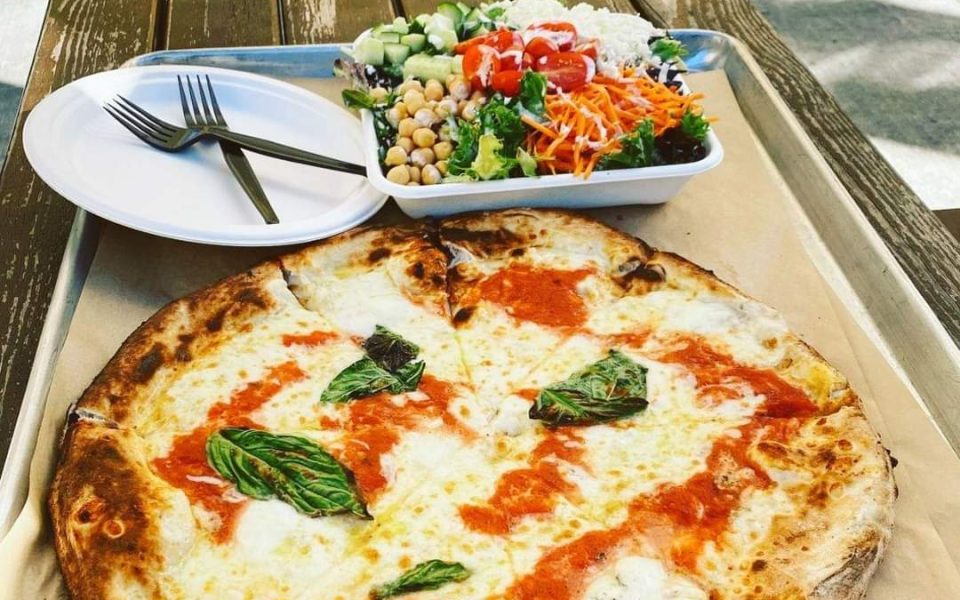Featured photo: Margherita pizza from Cugino Forno (courtesy photo)
I am perpetually consumed with thoughts of pizza — the crust, the sauce, the cheese and, most of all, the aesthetic. I have a whole section of my wardrobe devoted to what to wear while eating pizza. I have pizza-themed jewelry, pizza-themed bathroom décor; I even subscribe to a trade publication, Pizza Today, so I can keep up with national pizza restaurant trends.
All of that infatuation is just service-level appurtenance in comparison to others who live the art and craft of pizza-making. They are called the culinary arts for a reason, and I believe that reason begins with pizza.
There’s Chicago deep dish, Sicilian, Detroit-style (Think Little Caesars), California-style (thin crust with gourmet toppings), St. Louis-style, New Haven-style apizza (pronounced “ah-beets” by locals), NY-style and the original pizza — Neapolitan. Neapolitan-style pizza is characterized by a soft, tender crust that’s a little wet in the center with lots of black blisters around the rim caused by the highest temperatures in the oven. The char is the result of the cooking process and pure, simple ingredients are placed on top. The queen of all pizza styles dates all the way back to 18th century Naples. The most popular and simple style is the margherita: mozzarella di bufala cheese — made from Italian buffalo’s milk — tomato sauce and fresh basil. The art of its making is included on UNESCO’s list of intangible cultural heritage. This style of pizza gave rise to New York-style pizza that was first made by Italian immigrants in the US in the early 20th Century.
Making pizza seems like it could be as easy as tying your shoes but just as there was a lot of trial and error to learn that task, David Fleming of Winston-Salem is going through the learning process of perfecting homemade pizza. Fleming fell into pizza-making at the beginning of quarantine and hasn’t stopped since.
“I really like the Neapolitan style pizza and I wanted to recreate that at home,” Fleming says of his foray into pizza-making. “Part of the reason why I wanted to try it is because it looked so easy. But in the end, that is certainly not the case. I didn’t realize how involved it was. It seems so basic, but it really is an art form.”
He explained that while watching YouTube videos, he realized the process is more than mixing flour, salt and water to get a good crust.

Joseph Ozbay, owner/operator of Cugino Forno in Winston-Salem, Greensboro and Clemmons, admits that the hardest part is making the dough.
“Dough is like a living thing,” Ozbay says. “You really have to keep an eye on it because there’s only a couple of ingredients. It can get away from you if you’re not careful.”
He suggests starting with “00” flour and fresh yeast. Double zero, also referred to as doppio zero flour, is Italian flour ground to a fine powder. It creates a dough that is silky and maintains a chewiness when the gluten is properly hydrated and cooked. Yeast is indeed a living thing: the fungus responsible for kicking off fermentation in the dough and developing the complex flavors commonly identified in pizza crust.
Making the perfect pizza dough at home is a balance of ratios, timing and patience. For every 500 grams of flour, add 250 grams of water to achieve proper hydration. If the dough is too dry, it’s difficult to manipulate. If the dough is too wet, it becomes sticky and difficult to control. Resting the dough under refrigeration for 24 hours will help achieve the perfect balance for a perfect pizza.
“Make sure the dough rests to room temperature,” Ozbay says. “Otherwise, the gluten will seize up and the crust will be tough.”
There is no place for mediocrity to hide when so few ingredients are involved. After the dough is ready, says Ozbay, be sure to use a preheated oven.
“Preheat the oven and use the middle rack. If you don’t preheat the oven, the gluten will not release,” he says.
To stay true to tradition, at Cugino Forno, every ingredient is imported from Italy to stay true to the art form. The pizzaiolos even use bottled water to maintain consistency to ensure every pie tastes the same.
Their sauce is a blend of San Marzano or Italian plum tomatoes, sea salt, olive oil and black pepper.
While the classic Neapolitan-style pizza calls for simple ingredients to start, the toppings can be what lets creativity shine. Pepperoni is popular, but it’s also a fine time to find out if pineapple really does belong on pizza. Too many toppings and the dough is weighed down and all of the chemistry of the cooking process is lost. Toppings are a personal preference. No matter the size, any pizza can become a personal pizza if you try hard enough.
“Whenever you make pizza, it’s always a thing,” Fleming says. “You’re never going make just one with one topping. Before you know it, you have two or three prosciutto, pear, goat cheese pizzas with a honey drizzle.”
Join the First Amendment Society, a membership that goes directly to funding TCB‘s newsroom.
We believe that reporting can save the world.
The TCB First Amendment Society recognizes the vital role of a free, unfettered press with a bundling of local experiences designed to build community, and unique engagements with our newsroom that will help you understand, and shape, local journalism’s critical role in uplifting the people in our cities.
All revenue goes directly into the newsroom as reporters’ salaries and freelance commissions.


Leave a Reply